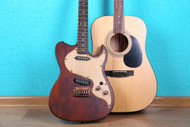The major differences between acoustic strings and electric strings
Jul 17th 2023
Whether you play an acoustic guitar, an electric guitar or both, you likely at some point have wondered if and how the strings differ from one another. Can you put acoustic strings on an electric guitar or electric strings on an acoustic guitar? If you're looking for simple answers to these and other questions, never fear: Strings and Beyond is happy to outline the major differences between acoustic strings and electric strings.
Electric and acoustic guitar strings differ in three major ways: winding materials, gauge and the number of wound strings. We'll take a look at these differences one by one.

Living in a Material World
The first big difference between acoustic and electric strings is the materials they are made of. Acoustic strings generally have brass or bronze coatings, while electric guitar strings generally have steel or nickel coatings. The reason electric guitars use these types of metals is because they have ferromagnetic properties. Electric guitars rely on these magnetic properties to generate volume through their pickups and amps.
On electric guitars, nickel generally provides richer, warmer low notes. Many consider these types of string ideal for genres like the blues. Steel strings tend to produce brighter sounds. These thin strings are popular for rock, metal and country.
Acoustic string materials include 80/20 bronze strings, which combine 80 percent copper with 20 percent zinc. (Bronze is an alloy made primarily of copper.) There are also pure bronze strings. The 80/20 strings tend to produce brighter tones than the all-bronze strings. The 80/20 strings tend to be popular among strummers, while the all-bronze strings tend to be used more for fingerpicking. Phosphor bronze strings are also available. These include a bit of phosphorus added to the metal. Many players think phosphor bronze strings provide a warmer and mellower tone.
String Gauge
String gauge simply refers to the thickness of a guitar string. It is measured in thousandths of an inch. Thus an .009 string would measure nine thousandths of an inch, while an .042 string would measure 42 thousandths of an inch. String manufacturers and guitarists typically refer to guitar string sets by the thinnest string in the pack. For example, a pack starting with a .009 string would be referred to as a pack of 9s.
Acoustic strings tend to be thicker than electric strings. In fact, they tend to average about 20 percent thicker than their electric counterparts. Why? The reason again gets back to how each type of guitar produces sound.

As you may recall, electric guitars rely on electromagnetism, pickups and amps to produce their unique and powerful sound. Acoustic guitars, on the other hand, have to rely on their shape, materials and design to produce sound. The greater the string mass, the slower the vibrations and the more resonant the sound produced will become. Thinner strings produce higher vibrations and higher pitch. Thus acoustic guitar strings have to be a bit thicker in order to provide rich sound. The increased thickness of the strings creates more vibration and more sound.
To help guitarists get the type of sound they want from their instruments, manufacturers divide string gauges into several categories: super light gauge, light, medium and heavy. The actual gauge thickness differs slightly for acoustic strings compared to electric strings. Super light gauge acoustic strings, for instance, start with an .010 E string, while super light gauge electric strings start with an .008 E string. At the other end of the spectrum, a heavy gauge acoustic set begins with an .013 gauge E string, while a heavy gauge electric set starts with an .012 gauge E string.

Winding It Up
The number of wound strings tends to differ on acoustic guitars compared to electric guitars. Acoustic guitars typically have four wound strings, while electric guitars usually only have three wound strings.
Why is there one less wound string on most electrics? Because electric guitars are typically played in a brighter style, having just three wound strings can make it easier to play aggressive tones, which can be especially important for leads. On the other hand, having a fourth wound string on an acoustic guitar makes it easier to produce adequate volume and sound without the aid of an amp or pickup that an electric instrument has.
Switching Electric and Acoustic Guitar Strings
Some folks wonder whether they can use electric guitar strings on an acoustic guitar or acoustic guitar strings on an electric guitar. The short answer is you could, but you probably shouldn't.
You can put acoustic strings on an electric guitar, but you'll get less volume, less range and less sustain. If you decide to put electric guitar strings on an acoustic guitar, you'll get less volume and sound. So unless you happen to be marooned on a desert island or otherwise unable to order the right set of strings for the type of guitar you have, it's best to use electric strings for electric guitars and acoustic strings for acoustics.
Final Thoughts
No matter what kind of guitar you play, we hope this guide has been helpful in shedding light on differences between electric and acoustic guitar strings, and why those differences are important. If you have additional questions about guitar strings, you can contact the experts at Strings and Beyond via phone or email. We can offer personalized recommendations and suggestions about what strings are right for your needs.

